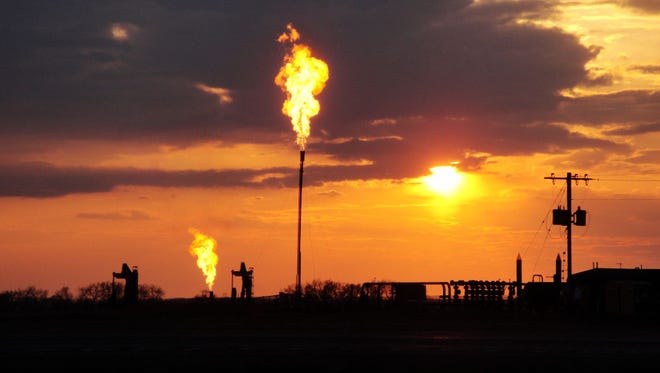Global Warming News about Methane Emissions from Oil and Gas Industry.
Oil and Gas Industry Is 25 to 40% More Responsible for Global Methane Emissions than Previously Thought
Olivia Rosane- February 20, 2020
The oil and gas industry may be contributing even more to the climate crisis than we thought.
A study published in Nature Wednesday found that methane emissions from fossil fuel extraction have been underestimated by 25 to 40 percent.
“This indicates that the fossil fuel sector has a much more polluting impact beyond being responsible for the overwhelming majority of carbon dioxide emissions,” Dr. Joeri Rogelj, a climate change lecturer at the Grantham Institute who was not involved with the research, told The Guardian. “This is worrying and overall bad news.”
While carbon dioxide is the greenhouse gas contributing the most to the climate crisis, methane is now responsible for 25 percent of current global warming, according to CNN.
The amount of methane in the atmosphere has more than doubled since the preindustrial era, according to The New York Times, but it has been difficult to pinpoint its source. Methane is released naturally by the ocean and by formations on land known as mud volcanoes. But it is also released by the fossil fuel industry, and most current estimates of the industry release of methane have been grassroots and not comprehensive, The Guardian pointed out.
“We have a really good understanding of how much methane concentrations have increased in the atmosphere,” study lead investigator and professor at the University of Rochester’s Department of Earth and Environmental Sciences Vasilii Petrenko told CNN. “But it’s difficult to track where the increases are coming from for a number of reasons.”
In order to get a better estimate, the University of Rochester team looked at methane data from before the industrial era. They measured air from around 300 years ago trapped in bubbles in glaciers in Greenland, The Guardian reported. This showed that the natural contribution to methane emissions was much lower than the number currently used to estimate emissions, The New York Times explained.
“We’ve identified a gigantic discrepancy that shows the industry needs to, at the very least, improve their monitoring,” study lead author Benjamin Hmiel told The New York Times. “If these emissions are truly coming from oil, gas extraction, production use, the industry isn’t even reporting or seeing that right now.”
The study does have a silver lining, however. If humans are responsible for the extra methane emissions, that means they can also control them, though this also means controlling the oil and gas sector.
“Placing stricter methane emission regulations on the fossil fuel industry will have the potential to reduce future global warming to a larger extent than previously thought,” Hmiel told The Guardian. “Methane is important to study because if we make changes to our current methane emissions, it’s going to reflect more quickly.”
From Doyle Rice, USA Today – February 19, 2020
- Emissions of methane have increased by approximately 150% over the past three centuries.
- Fossil methane can be emitted via natural geologic seeps or as a result of humans extracting and using fossil fuels.
The amount of methane that comes from burning fossil fuels is much higher than previously thought – as much as 40% higher, a new study suggests.
And the amount from natural sources is far lower.
Methane is a potent greenhouse gas, with more than 80 times the climate warming impact of carbon dioxide over a 20-year span. It is also the main ingredient in natural gas and is the second-largest contributor to global warming, after carbon dioxide.
Methane is emitted during the production and transport of coal, natural gas and oil.
Emissions of methane into Earth’s atmosphere have increased by about 150% over the past three centuries, but it has been difficult for researchers to determine exactly where these emissions originate.
10 years to save planet Earth:Here are 6 imaginative climate change solutions
In the study, researchers measured methane levels in ancient air samples from the Greenland ice sheet and found that scientists have been “vastly underestimating” the amount of methane humans are emitting into the atmosphere today via fossil fuels.
There are two types of methane: biological and fossil. Biological methane can be released naturally from sources such as wetlands or human-caused sources such as landfills, rice fields and livestock. Fossil methane, which is the focus of the study, can be emitted through natural geologic seeps or as a result of humans extracting and using fossil fuels.
Reducing fossil fuel use is crucial to reducing climate change, researchers say.
“Placing stricter methane emission regulations on the fossil-fuel industry will have the potential to reduce future global warming to a larger extent than previously thought,” said study lead author Benjamin Hmiel, a researcher at the University of Rochester.
“I don’t want to get too hopeless on this because my data does have a positive implication: Most of the methane emissions are anthropogenic (human-caused), so we have more control,” Hmiel said. “If we can reduce our (methane) emissions, it’s going to have more of an impact.”
That’s in contrast to carbon dioxide, which can persist in Earth’s atmosphere for up to a century: “If we stopped emitting all carbon dioxide today, high carbon dioxide levels in the atmosphere would still persist for a long time,” Hmiel said.
He added, however, that “methane is important to study because if we make changes to our current methane emissions, it’s going to reflect more quickly.”
The study was published Wednesday in the peer-reviewed British journal Nature.







